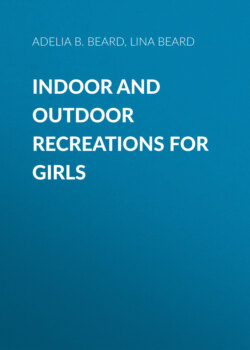Читать книгу Indoor and Outdoor Recreations for Girls - Adelia B. Beard - Страница 7
На сайте Литреса книга снята с продажи.
CHAPTER III
ОглавлениеTable of Contents
A BALL OF TWINE AND WHAT MAY BE MADE OF IT
Fig. 24.—The hammock you can make.
RUN to the kitchen and ask the cook to lend you her pastry-board for a day or two, to use as a support for holding string from which to make a toy hammock (Fig. 24).
Drive twelve large tacks in a straight line across the top edge of the board; place the tacks one inch and a half apart (Fig. 25), and with a pencil draw lightly a line across the board from side to side, one inch and a half below the tacks. This will guide you in keeping the knots even. Be sure that the line is perfectly straight; then draw another line one inch and a half below the first and continue making lines until the board is covered with them, at equal distances apart and running across from side to side. Over each tack on the top of the board hang a piece of string about two yards long (Fig. 26). Being doubled, each string makes two lengths of one yard each.
Fig. 25.—Tacks in top of board.
Fig. 26.—Over each tack hang a piece of string.
Bring the two ends of each strand down evenly together that all the strings may hang exactly the same in length. Fig. 26 is intended only to show how to hang the strings and gives but a section of the work.
Fig. 27.—With strong pins fasten the first and fourth strings to the board.
With strong pins fasten the first and fourth strings down tight to the board (see B and E, Fig. 27); then tie the second and third strings together (C, D, Fig. 27), making the knot H (Fig. 27).
To Tie the Knot,
Fig. 28.—When knot H is secure stick pin in string G.
bring the two strings C and D (Fig. 27) together; hold the upper portions with the thumb and first finger of the left hand and the lower parts in the right hand, bring the lower parts up above the left hand—across and over the portion of string held in the left hand—and turn them down a trifle, running them under the strings in the left hand just above the thumb and first finger; pull the lower portion of the strings through the loop out over the first finger of the left hand as shown in Fig. 29, O. Tighten the knot with the right hand while holding it in place on the line with the left. The secret of tying the knot properly is to hold the two strings together and tie them exactly as one would tie a knot in a single string.
Fig. 29.—Tying the knot.
When the first knot (H, Fig. 27) is tied, take the pin out of the string E and stick it in the string G, according to Fig. 28. Fasten down the knot H with another pin, and you will have the knot H and the string G firm and tight to the board while you tie the two loose strings F and E together, forming the knot K. Pin this down to the board and remove the pin from the string G and place it in the string N, leaving M and G free to be knotted together.
Continue tying the strings in this way until you have made the first row of knots across the board, always using pins to hold the boundary-strings securely to the board on each side of the two you are tying. As each knot is formed, pin it to the board and allow the pins to remain in the first row until the second row of knots has been made.
Fig. 29 shows the beginning of the third row of knots in the knot P, the pin being taken from the first knot, H, ready to be placed in the knot P. Form row after row of meshes by knotting the strings until the netting comes too near the bottom of the board to work comfortably, then slip the top loops off from the tacks and hang a portion of the net over the top of the board, allowing a lower row of meshes to hang on the tacks.
Fasten the last row of the knots carefully, binding with strong strings the short loose ends of the strands securely to the string forming the mesh each side of the knot. Remove the net from the board and make
